| Location | Brooklyn, New York, USA |
| Date | 1994-2000 |
| End User | Community members in a catchment area of 200 000 people |
| Client | New York Unified Court System |
| Implementing Partner | Center for Court Innovation |
| Design Firm | Alta Indelman |
| Engineering | B. Thayer Associates, Jack Green Associates, James Wiesenfeld & Associates |
| Lightning Design | Domingo Gonzales Associates |
| Contractor | York Hunter |
| Consultants | Davis Brody Bond Architects, City of New York, State of New York, US Department of Justice |
| Cost | $5.47 million USD |
| Area | 20 000 sq ft |

Front Entrance to Red Hook Community Justice Center. Photo: Elizabeth Felicella Photography
The United States leads the world in the number of people incarcerated. During the 1990s a movement began to address the issues that lead to high recidivism rates. Community court is an effort to reform the courtroom from the inside out. The Center for Court Innovation, a public-private partnership was in New York City in 1993 to serve as the research and development arm of the city’s court system and pilot demonstration projects. Its research showed that a large number of the people who failed to appear in court were charged with minor offenses, clogging courtroom dockets and resulting in more serious consequences for the accused. In part, this was because the court date was often several weeks after the time of arrest and courtroom would often be in another part of the city that was difficult for them to reach. To address this problem, the center established community courts where defendants are held for trial, appear before a judge, and, if convicted, serve their sentence all from a community justice center located in the same neighborhood as their arrest.
The Community Court model was first piloted in four neighborhoods with high rates of nonviolent crime in the New York area. At a Community Court, defendants are held in a holding cell onsite while they await trial rather than being transfered to the city’s jail. They come before the judge within 24 hours. A single judge handles cases that would ordinarily go to three different courts: criminal, civil and family. By handling minor crimes, delinquency matters and landlord-tenant disputes in one place, the judge is able to try offenders in the context of the community.
If convicted they immediately serve their sentence before being released. Unlike a traditional court where defendants are scheduled to serve their sentence at a later date at a different location.
Community service projects are aimed at paying back the community where the crime was committed. The projects usually consist of cleanup or physical labor. For some offenders who need extra supervision, rooms are set up within the court (right next to the desk of the community service coordinators) where they can complete community service hours inside. Part of the sentence may also include social services. Access to city agencies, job training and substance abuse treatment programs are all located onsite.
Swift sentencing “sends the message to offenders that crime has consequences and that they will be held accountable for their actions,” says Greg Berman, the director of the Center for Court Innovation. “Downtown, I only have jail or out. Here, I have a number of different tools to use to get to people’s problems so that they don’t come in front of me again,” explains Judge Alex Calabrese, of Brooklyn’s Red Hook Community Justice Center. Max Johnson, a former offender who has appeared before judges at both Red Hook and traditional courts, says he appreciates the Community Court model. “The difference between Red Hook and other courts is when you go to regular courts you just see a lawyer and they talk about the case. There is no concern about the real problems of the person.”
This innovative approach to justice required re-engineering the physical layout of the courthouse as well. To assist designers in rethinking the architectural blueprint of the traditional courthouse for new Community Courts, the Center for Court Innovation created a set of design criteria.
The look and feel of the Community Courthouse is less institutional and more friendly. Some common changes to the standard court layout include: Community Courts have a street presence, invite citizens to walk in if they need services; they have spaces set aside for community meetings, mediation and classes; glass panels replace holding cell bars; and someone is stationed at the front to assist visitors. These features, among others, make the look and feel less institutional and more friendly.
One of the key components is office spaces that house social workers and liasons across a range of social services providers and city agencies, including social workers, job-training coordinators, social counselors, drug and mental health coordinators and community service coordinators.
At the Red Hook Community Court in Brooklyn, pictured here, the open-air office allows these agencies, which are typically housed in different locations, to work within arm’s reach of each other, making support for cases quick and effective.
Beyond the conventional court business, Community Court may also house programs addressing a specific community issue or needs of a target population. A popular Red Hook program is the youth court, run entirely by specially trained teenagers. The youth court handles low-level cases referred by either the police or the court. The idea is simple: to use peer pressure as a positive force to get troubled teens back on track. The youth court’s meeting room at Red Hook Justice Center is directly across the hall from the holding rooms of offenders, offering a real perspective of the consequence of crime.
The results of the Community Courts have been overwhelmingly successful. For example, the police precinct local to the Red Hook Justice Center is now the safest in Brooklyn. An independent survey of defendants sponsored by a grant from the US Department of Justice revealed that 86 percent felt their case was handled fairly by the Community Court. The report concluded that “by offering a wider range of non-custodial sentences (including social and community services), Red Hook Community Justice Center is offering a more transparent and collaborative atmosphere for defendants, all of which may heighten defendant perceptions of fairness.”
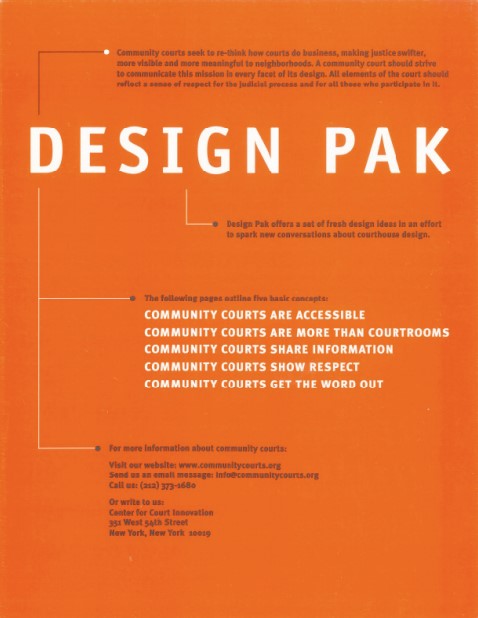
The design guidelines. Courtesy of Center for Court Innovation
Design Pak for Community Courts
Community courts seek to re-think house courts do business, making justices swifter, more visible and more meaningful to neighborhoods. A community court should strive to communicate this mission in ever facet of its design. All elements of the court should reflect a sense of respect for the judicial process and for all those who participate in it. Design Pak offers a set of fresh design ideas in an effort to spark new conversations about courthouse design.
THE FOLLOWING PAGES OUTLINES FIVE BASIC CONCEPTS:
- Community Courts are accessible
- Community Courts are more than courtrooms
- Community Courts share information
- Community Courts show respect
- Community courts get the word out
Community courts are accessible — design can make the court welcoming
- Makes courtroom proceedings visible and audible to all; a smaller courtroom can often encourage greater intimacy.
- Recognize the importance of street presences – a prominent neighborhood location and visible signage send the message that the course welcomes citizen participation.
- Place prominent and uniform direction signs in public spaces.
- Let visitors know who the judge is- post his/her name at the entrance of the courtroom.
Community Courts are more than courtrooms — New partners can help the court solve neighborhood problems
- The court should be a resource for the entire community – set aside space for community meetings, mediation, and evening classes; use glass doors to communicate a sense of openness.
- Seize the moment of arrest by locating counselors, job trainers and educators on site, under one roof; an open office plan will enhance communication.
- Some offenders sentenced to community service may benefit from the extra supervision that comes with being on-site.
- Set up a health clinic to address public health issues like tuberculosis and sexually transmitted diseases that affect individuals as well as the community.
Community Courts share information — Easy access to information can improve the delivery of services
- Place the daily court calendar where it can be seen by both the public and defendants.
- Provide the public with information about health care, job training and how to negotiate the court system.
- Station someone at the entrance of the court to assist visitors.
- Advertise on-site social services with large, bilingual posters.
- Use technology to link the courtroom to social services and community services sites, ensuring that shared information is accurate and up-to-date.
Community Courts show respect — All areas can exhibit respect for the judicial process
- Keep lawyering out of the hallways – create a private and accessible area for defendants to meet with their attorneys.
- By making holding cells dignified – including a pay phone, sink, and mirror, and privacy partition for the toilet – the court can positively influence the behavior of the defendants.
- Use secure glass panels instead of bars to improve visibility for guards and habitability for defendants.
- Sentence offenders to community service work crews that keep the courthouse spotless.
- Advertise ‘success stories’ – defendants who have succeeded in treatment or who have been placed in jobs.
Community Courts get the word out — Let the community know about the court’s work
- Create a name for the court that reflects its roots in the community; use logo consistently, on everything from stationary to banners to community service uniforms.
- Develop visible community service projects that ‘pay back’ the neighborhood.
- Create vehicles for the public to learn what’s going on – websites, newsletters, videos, etc.
- Post “before” and “after” photos of the community service projects – tree plantings, graffiti removal, etc.
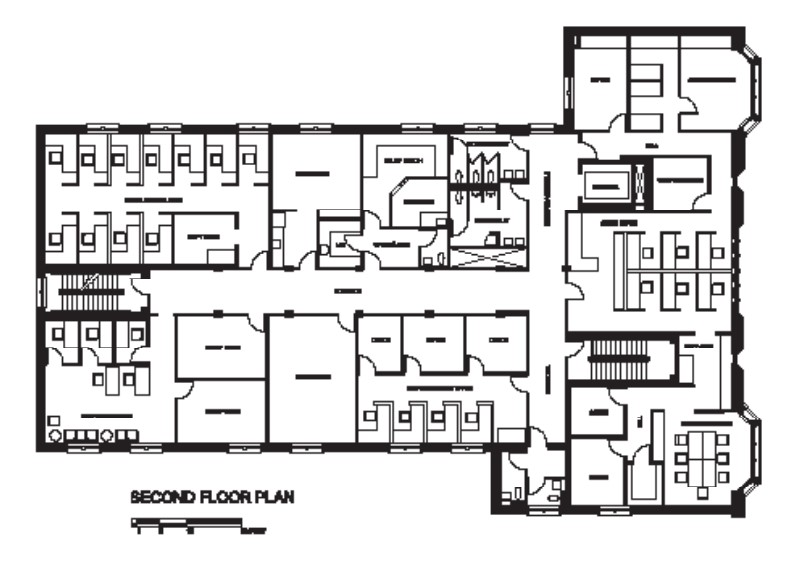
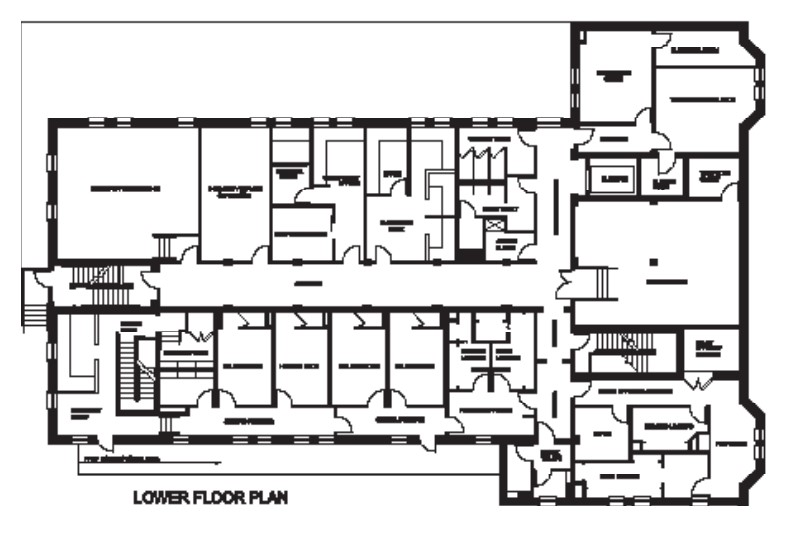
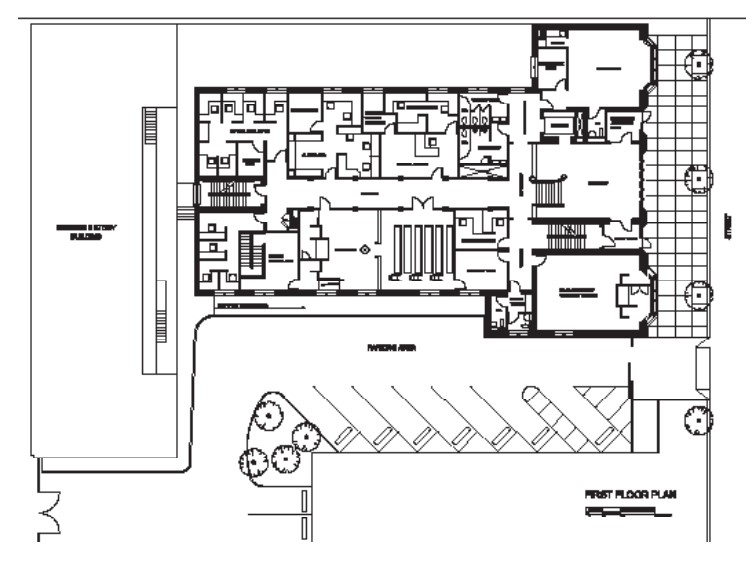
top left, top right & above images: Floor plan of the Red Hook Community Justice Center, an example of how courts adapt space for community engagement. Image: Alta Indelman
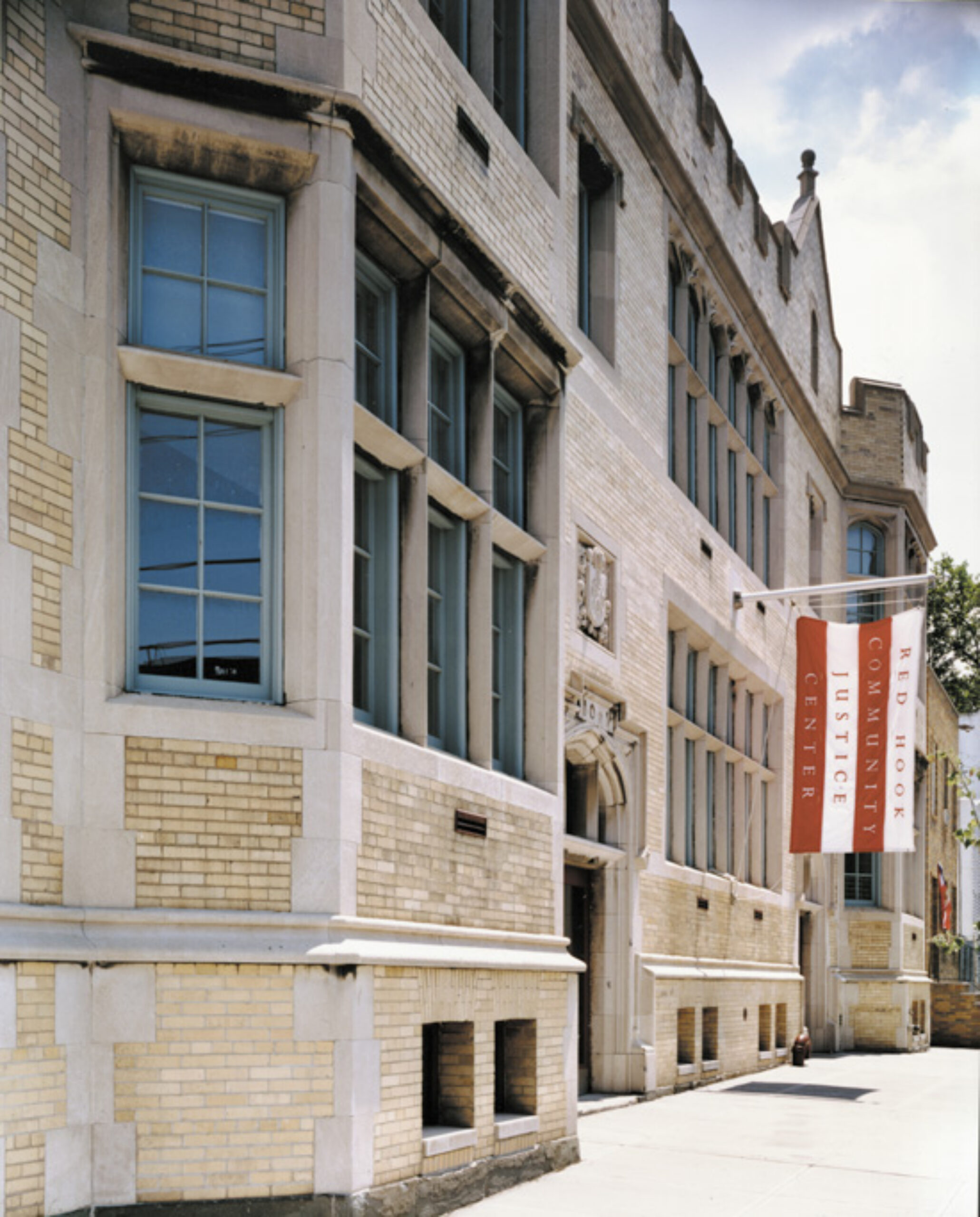















READ OR LEAVE A COMMENT